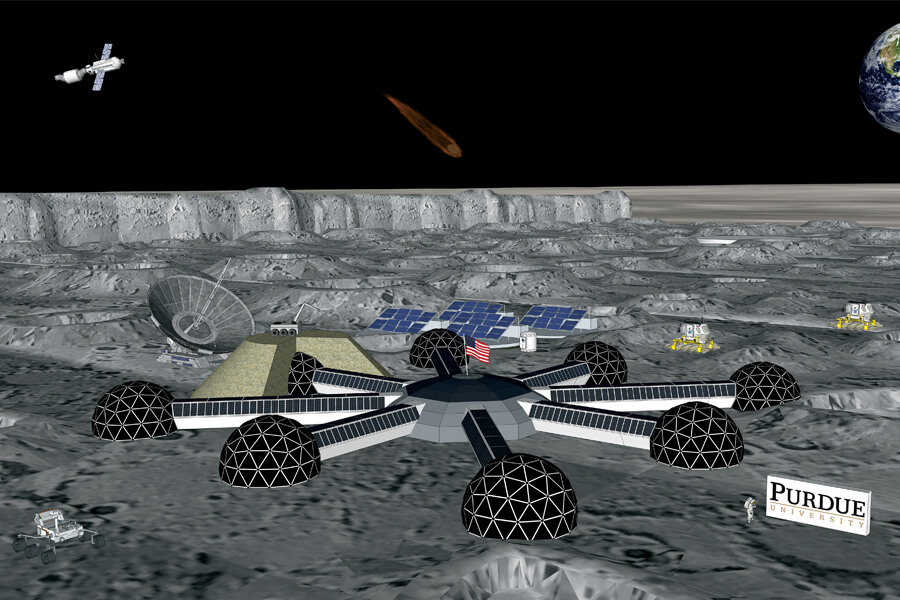If you’re an engineer who studies how to build in extreme environments on this planet, there’s a surprisingly common aspect of habitat designs now being proposed for the moon or Mars. “Many of those concepts are very unrealistic,” says Shirley Dyke, professor of mechanical engineering and civil engineering. “They would fail very quickly, with some fault that propagates through the system.”
This realization was one early driver for the Resilient ExtraTerrestrial Habitats Institute (RETH), a multi-institutional research program launched this spring with backing from the National Aeronautics and Space Administration (NASA). RETH will systematically investigate ways to make living environments in deep space able to detect and quickly respond to failures without outside help, says Dyke, who is the principal investigator.
There’s no lack of challenges for space habitats, ranging from extreme temperatures and radiation to meteorites, moonquakes and Marsquakes. And there are no baby steps in space. While the moon may be a logical stepping stone toward Mars and other locations, “the moon is an even more extreme environment than Mars,” Dyke says. “The cold is colder and the hot is hotter, and there are fewer resources.”
Looking at ways to safely house humans in such tough terrains, RETH focuses on resilience and autonomy. “We don’t want to build the impossible perfect habitat,” she says. “Our objective is to learn how to model these habitats, with an intelligent ‘SmartHab’ system that can detect and diagnose faults and then adapt to deal with them. This SmartHab would all be basically autonomous, working with the humans in the habitat without requiring the humans to make every decision or control everything.”
New Horizons in space
RETH’s roots are in the New Horizons initiative rolled out by the Purdue Provost’s Office in 2017. New Horizons asked senior faculty to propose new academic and research programs in fields where Purdue could play a leading role. “Several of us had experience in extreme environments like earthquakes and windstorms, and we eventually came up with the concept of taking that experience to the problem of building space habitats,” Dyke recalls.
With backing from New Horizons, in 2017 she and her colleagues constituted a multidisciplinary group of five faculty in a project that began tackling these challenges. The following year, when NASA asked for proposals for space technology research institutes, the Purdue team made a bid with colleagues at Harvard University, the University of Connecticut and the University of Texas at San Antonio. In April 2019, NASA announced it would support RETH with up to $15 million of funding over five years.
RETH’s 21 investigators are pursuing three main research thrusts. One thrust is architecture, examining key systems in the habitat and how they interact, led by Karen Marais, Purdue associate professor of aeronautics and astronautics. A second effort is in smart capabilities, developing techniques and algorithms for intelligent monitoring, headed by James Braun, Purdue’s Herrick Professor of Engineering. The third research theme is in creating autonomous robotic repair and maintenance capabilities, led by Harvard senior research scientist Justin Werfel.
Ramesh Malla, professor of civil and environmental engineering at the University of Connecticut, spearheads industrial collaboration. The first two corporate partners are UTC Collins Aerospace, which makes environmental control and life support systems, and ILC Dover, best known for inflatable habitats.
Key throughout RETH is the concept of resilience, which is not simply robustness or redundancy.
“You can’t just use traditional risk assessment methods to look at something that’s as complex as a space habitat and will handle the types of extreme situations that the habitat will experience,” Dyke says. “There will eventually be some sort of event — a meteorite strike, a sandstorm, radiation damage to your computers, or something completely unforeseen yet. You just have to be able to deal with it.
“A combination of humans and robots working in synergy will be critical,” she adds. “A computer may be the best alternative for making decisions when you’re dealing with the expected, but humans tend to be more astute when you’re dealing with the unexpected.”
SmartHab, smart learning
One RETH centerpiece will be a scaled habitat facility at the Herrick Laboratories. This prototype will be a hybrid simulator, mixing physical testing with computational models. “Our SmartHab will be like a plug-and-play system where we don’t have to build the whole habitat. We can build pieces of it and then test it with computational elements in a virtual mode,” Dyke says.
The SmartHab testbed could simulate different concepts of space habitats being developed by many groups around the world, and look at their pros and cons. For instance, some pioneering space groups are envisioning Mars settlements with many habitat modules. “We may build one or two modules and simulate the rest, which are all interconnected,” she says. “You might have the power supply in one of them and water being generated in another one, for example. If one of those fails, then how does that affect the habitat where the humans are living?”
Professors in aeronautics and aerospace engineering, civil engineering, industrial engineering and mechanical engineering are engaged in RETH, and other departments may join the team as well — opening up a wealth of opportunities for students. “In civil engineering, for example, students may want to pursue career paths that take what they learn about building in extreme environments on Earth and bring it to space habitats,” Dyke says. “We have many novel ideas about how this program can impact academics here.”
Photo At Top:
“There will eventually be some sort of event – a meteorite strike, a sandstorm, radiation damage to your computers, or something completely unforeseen yet. You just have to be able to deal with it.”
— Shirley Dyke

Members of Purdue University’s new Resilient ExtraTerrestrial Habitats Institute are studying the hurdles in building habitats like this on the moon or Mars.
Purdue University image – RETH Institute
